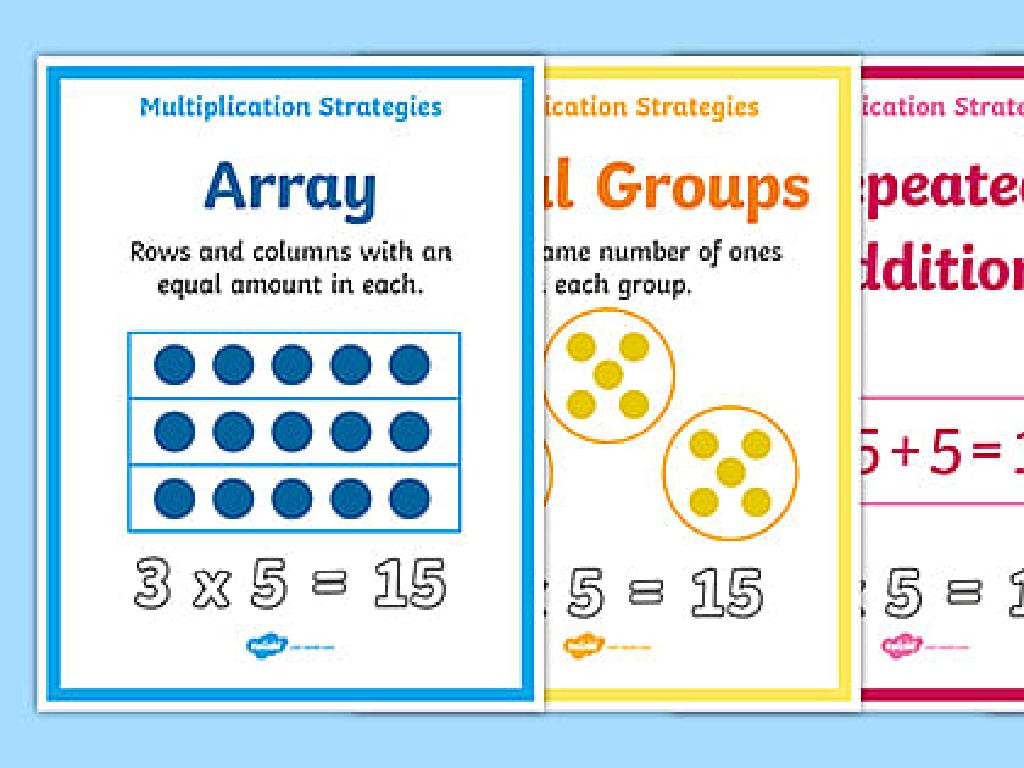Estimate Products Of Mixed Numbers
Subject: Math
Grade: Sixth grade
Topic: Multiply Fractions
Please LOG IN to download the presentation. Access is available to registered users only.
View More Content
Estimating Products of Mixed Numbers
– Grasp the concept of fractions
– Fractions represent parts of a whole
– Multiplying fractions explained
– To multiply, multiply the numerators and denominators
– Real-life applications
– Used in cooking, crafting, and budgeting
– Estimation techniques
– Round mixed numbers to estimate the product
|
This slide introduces students to the concept of multiplying fractions, which is a foundational skill in mathematics. Begin by ensuring that students have a solid understanding of fractions as parts of a whole. Explain the process of multiplying fractions by multiplying the numerators together and the denominators together. Emphasize the practicality of this skill by discussing how it is used in everyday life, such as in recipes or dividing resources. Finally, introduce estimation techniques for mixed numbers, which can simplify calculations and help check the reasonableness of answers. Encourage students to practice by estimating products of mixed numbers they encounter in real-life scenarios.
Estimating Products of Mixed Numbers
– Understanding estimation
– An estimate is a close guess of the actual value.
– The purpose of estimating
– Estimation helps simplify complex math problems.
– Estimation versus exactness
– Knowing when to estimate and when to calculate precisely.
– Practice estimation with examples
|
This slide introduces the concept of estimation in the context of multiplying fractions, specifically mixed numbers. Begin by explaining that an estimate is a rough calculation of a number. It’s not exact, but close enough to give us a useful answer. Discuss why estimation is a valuable skill in math: it helps us quickly solve problems when an exact number isn’t needed, and it’s a good way to check the reasonableness of an answer. Contrast estimating with finding the exact answer, highlighting situations where each is appropriate. Finally, provide examples of estimating products of mixed numbers to demonstrate how to apply this skill. Encourage students to practice by estimating before multiplying to check their work.
Multiplying Whole Numbers by Fractions
– Review: Multiplying whole numbers
– Steps to multiply by a fraction
– Multiply the whole number by the numerator, then divide by the denominator
– Example: Multiply 4 by 3/5
– 4 x 3/5 = 4 x 3 ÷ 5 = 12 ÷ 5 = 2.4
– Practice with similar problems
– Try 5 x 4/7 or 3 x 2/3 for homework
|
Begin by reviewing the multiplication of whole numbers to ensure students are comfortable with basic multiplication. Then, introduce the concept of multiplying a whole number by a fraction, emphasizing that the process involves multiplying the whole number by the numerator of the fraction and then dividing the result by the denominator. Use the example 4 x 3/5 to illustrate this process step by step. Encourage students to visualize the multiplication as combining groups of a fraction. After explaining the example, provide additional problems for students to practice, such as 5 x 4/7 or 3 x 2/3, to reinforce the concept and prepare them for estimating products of mixed numbers.
Estimating Products of Mixed Numbers
– Understanding mixed numbers
– A mixed number has a whole part and a fraction part, e.g., 2 1/3.
– Convert to improper fractions
– Multiply whole number by denominator, add numerator, e.g., 2 1/3 becomes 7/3.
– Multiplication example
– 2 1/3 x 3 3/4 = 7/3 x 15/4. Multiply numerators and denominators.
– Estimation techniques
– Round mixed numbers before multiplying for an estimate.
|
Begin by explaining what a mixed number is, ensuring students can identify the whole number and fractional parts. Demonstrate how to convert mixed numbers into improper fractions, which is a crucial step before multiplication. Use the example 2 1/3 x 3 3/4 to show the conversion process and the multiplication of the resulting improper fractions. Emphasize the importance of estimation techniques to quickly approximate the product of mixed numbers, which can be particularly useful in real-world scenarios where exact answers are not necessary. Encourage students to practice these steps with additional examples.
Estimating Products of Mixed Numbers
– Round mixed numbers to nearest whole
– Round 5 1/2 to 5 and 2 2/3 to 3
– Use estimation to verify answers
– Estimation helps check if an answer is reasonable
– Example: Estimate 5 1/2 x 2 2/3
– 5 x 3 = 15, so 5 1/2 x 2 2/3 is about 15
– Practice estimation with exercises
|
This slide introduces students to the concept of estimating the product of mixed numbers as a way to quickly gauge the reasonableness of their answers. Start by explaining how to round mixed numbers to the nearest whole number, which simplifies the multiplication process. Emphasize that estimation is a useful skill for checking work and ensuring that answers make sense in context. Use the example provided to demonstrate the process step by step, and then encourage students to practice with additional problems to solidify their understanding.
Estimating Products of Mixed Numbers
– Practice with Example 1
– Estimate 7 3/8 x 4 1/2 by rounding to nearest whole numbers: 7 x 5 = 35
– Practice with Example 2
– Estimate 6 2/5 x 3 3/4 by rounding to nearest whole numbers: 6 x 4 = 24
|
This slide is designed for a practice activity where students will apply their knowledge of estimating products of mixed numbers. Start by guiding them through Example 1, rounding each mixed number to the nearest whole number before multiplying. Repeat the process with Example 2. Encourage students to explain their rounding choices and how they arrived at their estimates. This exercise will help solidify their understanding of estimation and prepare them for more complex multiplication of mixed numbers. Provide additional examples if time allows and ensure that students are comfortable with the estimation process before moving on.
Class Activity: Estimation Stations
– Break into small groups
– Rotate through estimation stations
– Each station has unique problems to estimate mixed number products
– Share your estimates
– Compare your group’s results with others
– Discuss findings with the class
– Open discussion on different estimation strategies used
|
This interactive class activity is designed to help students practice estimating the products of mixed numbers. Divide the class into small groups to foster teamwork. Set up stations around the classroom, each with a different set of estimation problems involving mixed numbers. Students will rotate through these stations, working with their group to solve the problems. After completing the rotations, each group will share their estimates with the class. Facilitate a discussion on the various methods used for estimation and the reasoning behind the students’ thinking. This will help them understand different approaches and improve their estimation skills. Possible activities at each station could include estimating the cost of groceries, the total distance traveled in a week, or the amount of paint needed for a mural, all involving mixed number multiplication.
Lesson Recap & Homework Assignment
– Review of estimating products
– Estimation’s role in daily life
– Helps in quick decision making & budgeting
– Homework: Estimate 3 mixed numbers
– Use estimation methods learned today
– Practice makes perfect
– Keep practicing to improve your skills
|
As we conclude today’s lesson on estimating products of mixed numbers, it’s important to emphasize the real-world application of estimation. It’s a skill that aids in making quick decisions, such as when shopping or cooking. For homework, students are tasked with estimating the product of three mixed numbers using the techniques learned in class. This will reinforce their understanding and help them become more comfortable with the concept. Encourage students to show their estimation steps and to check their work by comparing it to the actual product if possible. Remind them that estimation is not about getting the exact answer but about getting close enough quickly.






